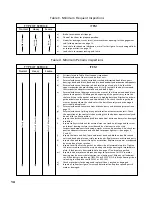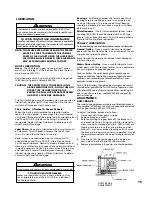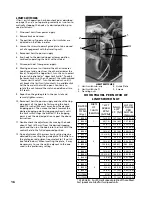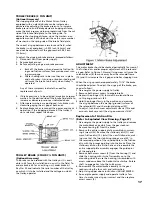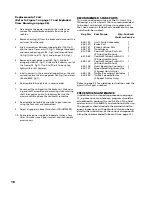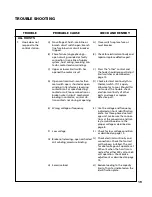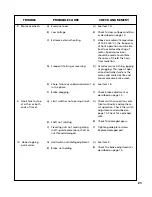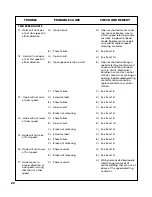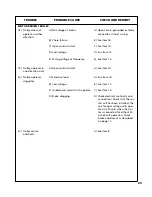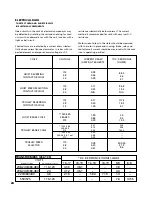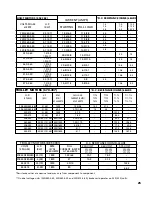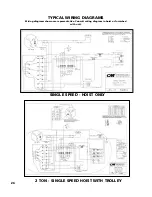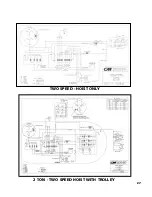
12
GENERAL
1. The Protector is designed to allow the first reduction gear
to slip on an excessive overload. An overload is indicated
when the hoist will not raise the load. Also, some clutching
noise may be heard if the hoist is loaded beyond rated
capacity. Should this occur, immediately release the
(Up)
control to stop operation of the hoist. At this point, the
load should be reduced to the rated hoist capacity or the
hoist should be replaced with one of the proper capacity.
When the excessive load is removed, normal hoist opera-
tion is automatically restored.
CAUTION: THE PROTECTOR IS SUSCEPTIBLE TO OVER
HEATING AND WEAR WHEN SLIPPED FOR
EXTENDED PERIODS. UNDER NO CIRCUM-
STANCE SHOULD THE PROTECTOR BE
ALLOWED TO SLIP FOR MORE THAN A FEW
SECONDS.
Due to the above, a hoist equipped with a Protector is not
recommended for use in any application where there is a
possibility of adding to an already suspended load to the
point of overload. This includes *dumbwaiter installations,
containers that are loaded in mid-air, etc.
*Refer to limitations on Page ii concerning dumb-
waiter applications.
Also, if a XL Hoist with a Protector is used at unusual
xtremes of ambient temperatures, above 150°F (65°C) or
below 15° F (-9°C) changes in lubricant properties may
permit the hoist to raise larger loads than under normal
operating conditions and presents possibility of damage
or injury.
2. All hoists are equipped with an adjustable screw
limit switch, which automatically stops the hook at
any predetermined point when either hoisting or lowering.
3. The control station used on two speed hoists is similar to
single speed unit, except that either of two definite
speeds may be selected by the operator in both
hoisting and lowering. Each control when partially
depressed provides SLOW speed and when fully
depressed gives FAST speed. Partial release of con-
trol returns hoist to slow speed, while complete
release allows hoist to stop. Rated lifting speeds are
shown on hoist identification plate. SLOW speed is
intended as a means of carefully controlling or
“spotting” the load, although the hoist may be
operated solely at this speed if desired. It is not nec-
essary to operate in the SLOW speed position as the
hoist will pick up a capacity load at FAST speed
from a standing start. In other words, it is not nec-
essary to hesitate at the slow position when moving
control from STOP and FAST position or vice versa.
4. Do not use this or any other overhead materials han-
dling equipment for lifting persons.
5. Stand clear of all loads and avoid moving a load over
the heads of other personnel. Warn personnel of
your intention to move a load in their area.
6. Do not leave load suspended in air unattended.
7. Permit only qualified personnel to operate unit.
8. Do not wrap the load chain around the load and
hook onto itself as a choker chain.
Doing this will result in:
a. The loss of the swivel effect of the hook which
could mean twisted chain and a jammed lift
wheel.
b. The upper limit switch is by-passed and the load
could hit the hoist.
c. The chain could be damaged at the hook.
9. On double and triple reeved hoists, check for twists
in the load chain. A twist can occur if the lower
hook block has been capsized between the strands
of chain. Reverse the capsize to remove the twist.
10. Do not allow the load to bear against the hook
latch. The latch is to help maintain the hook in posi-
tion while the chain is slack before taking up slack chain.
11. Take up a slack load chain carefully and start load eas
ily to avoid shock and jerking of hoist load chain. If
there is any evidence of overloading, immediately
lower the load and remove the excess load.
12. Do not allow the load to swing or twist while hoisting.
13. Never operate the hoist when flammable materials or
vapors are present. Electrical devices produce arcs or
sparks that can cause a fire or explosion.
14. STAY ALERT! Watch what you are doing and use
common sense. Do not use the hoist when you are
tired, distracted or under the influence of drugs,
alcohol or medication causing diminished control.
INSPECTION
To maintain continuous and satisfactory operation, a
regular inspection procedure must be initiated to
replace worn or damaged parts before they become
unsafe. Inspection intervals must be determined by the
individual application and are based on the type of ser-
vice to which the hoist will be subjected and degree of
exposure to wear, deterioration or malfunction of the
critical components.
WARNING
Allowing the load to bear against the hook latch
and/or hook tip can result in loss of load.
TO AVOID INJURY:
Do not allow the load to bear against the hook latch
and/or hook tip. Apply load to hook bowl or saddle
!
MAINTENANCE
The type of service to which the hoist is subjected can be
classified as “Normal,” “Heavy,” or “Severe.”
Normal Service: Involves operation with randomly distrib-
uted loads within rated load limit, or uniform loads less
than 65 percent of rated load for not more than 25 per-
cent of the time.
Heavy Service: Involves operating the hoist within rated
load limit which exceeds normal service.
Severe Service: Normal or heavy service with abnormal
operating conditions.
Two classes of inspection—
Frequent and Periodic
—
must be performed.
FREQUENT INSPECTIONS:
These inspections are visu-
al examinations by the operator or other designated per-
sonnel. Records of such inspections are not required. The
frequent inspections are to be performed monthly for
normal service, weekly to monthly for heavy service, and
daily to weekly for severe service, and they should
include those items listed in Table 3.
PERIODIC INSPECTIONS:
These inspections are visual
inspections of external conditions by an appointed per-
son. Records of periodic inspections are to be kept for
continuing evaluation of the condition of the hoist.
Periodic inspections are to be performed yearly for nor-
mal service, semi-annually for heavy service and quarterly
for severe service, and they are to include those items
listed in Table 4.
CAUTION: ANY DEFICIENCIES ARE TO BE CORRECTED
BEFORE THE HOIST IS RETURNED TO SER-
VICE. ALSO, THE EXTERNAL CONDITIONS
MAY SHOW THE NEED FOR DISASSEMBLY
TO PERMIT A MORE DETAILED INSPECTION,
WHICH, IN TURN, MAY REQUIRE THE USE
OF NONDESTRUCTIVE TYPE TESTING.
HOOK INSPECTION
Hooks damaged from chemicals, deformations or cracks,
or that have more than a 10° twist from the hook’s
unbent plane, excessive opening or seat wear must be
replaced. Also, hooks that are opened and allow the
latch to not engage the tip must be replaced. Any hook
that is twisted or has excessive throat opening indicates
abuse or overloading of the unit. Inspect other load sus-
taining parts for damage.
On latch type hooks, check to make sure that the latch is
not damaged or bent and that it operates properly with
sufficient spring pressure to keep the latch tightly
against the tip of the hook and allow latch to spring
back to tip when released. If latch does not operate
properly, it should be replaced. See below to determine
when the hook must be replaced.

















